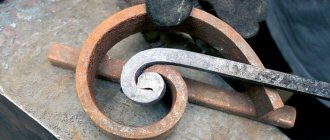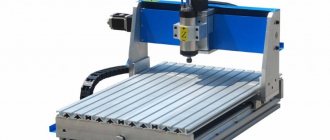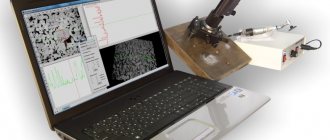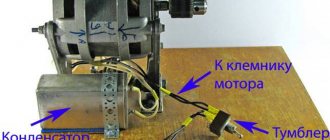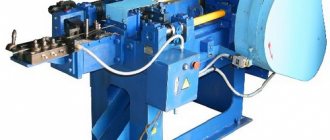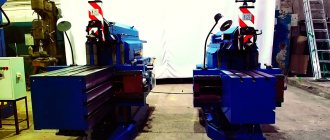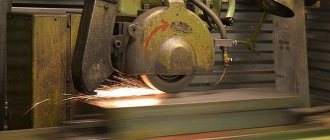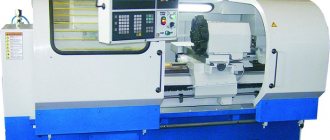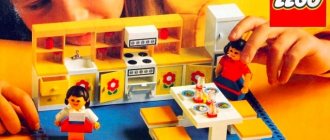First, a little physics. Forging as a process in general is the processing of metals by heating them. Hammers, anvils, furnaces, powerful blacksmiths in leather aprons - this is all about hot forging and classical blacksmithing. There are professionals, expensive equipment, separate premises - it’s not a cheap job. We are talking about a completely different process - cold forging.
If you look at it, this technology is not forging. It would be more correct to call it bending metal rods; sometimes it is called “flexible”. But, since the term “artistic cold forging” has already been established among numerous ranks of metal craftsmen, we will use generally accepted terms.
Features of cold forging
All artistic forging consists of continuous bends, waves, curls - all of them of different sizes, in various combinations. You cannot bend metal with your hands, even if it is the softest. Therefore, the only main method of cold forging is metal processing by machine. Each metal element has its own tool.
Composition of artistic forging.
Forged staircase.
Interior with forged elements.
Metal balcony.
An example of cold forging.
The first thing you need to do is get them, but first understand the types of cold forging machines. The complexity of such equipment is low, and so is its cost.
If you are going to do blacksmithing for yourself, a few hand-cranked tools will be enough for you. The pace of work on manual equipment is slow, but the costs of production and use are much lower. Electric drives will only be needed in cases of commercial forging to order, then the game will cost the candle.
Special machines for cold forging are a whole bunch of options; they can be manually controlled or with electric motors, homemade or purchased. To embody all conceivable and inconceivable artistic ideas in metal, 5–7 types will be enough. At least half of them can be made yourself.
The main thing is to remember that cold forging of metal is possible for anyone who has the desire and perseverance. Before deciding to start cold forging work, you need to understand some of the nuances of this technology and the types of special equipment.
Hand tools for forging. Price
To produce complex forged structures, professional equipment with an electric motor or hydraulics is used.
The most accessible to use and price is a hand tool for cold forging, which can be bought in specialized stores. The manual curl bending machine MZ- V 1 will allow you to produce basic forged products of various configurations.
Its kit includes a support for working with long workpieces, clamping eccentrics for squares and strips, and a mandrel for making curls. The price of equipment is from 19,700 rubles. R longitudinal twisting hand tool is designed for use in domestic conditions.
It is most often used for the manufacture of various kinds of gratings, forged metal fences, railings, and for finishing loggias and balconies. The device comes with special mandrels for twisting squares and strips. The MZ-T R machine costs 16,920 rubles. Manual equipment MV20-12 , which is used to bend various metal elements with a small cross-section (strip, rod, wire, etc.).
Suitable for model making and other work with thin materials. The price for the MV20-12 machine is 6,390 rubles. MV10-6 is a small hand tool that is convenient for bending metal into a ring or arc.
It is used in the manufacture of flower stands, sconces, chandeliers and other lamps. In this case, strips and rods, wire made of ferrous or non-ferrous metal with a diameter of up to 6 mm, squares 6x6 mm are used. To make it convenient to work, the machine was equipped with a 340 mm long handle and an upper roller with precise adjustment. Such equipment will be useful for home craftsmen when creating openwork products and metal structures, metal art masters, artisans, and schools. MV10-6 costs 9,045 rubles. The MO5-GX manual machine is designed for easy and quick production of the most popular elements in forging - “clamps”. Its use does not require great skills in blacksmithing, since it is not at all difficult to operate. The price of such a machine is 10,692 rubles.
The universal bending machine MV30-6x50 will be convenient to use in a small workshop, in a country house or in a garage for bending metal profiles, pipes, squares, rods, strips.
With its help, you can produce many bending options in different planes and different configurations. The forging tool is equipped with convenient stops and bending mandrels. MV30-6x50 costs 11,385 rubles. The manual pipe bending machine MO7-T G is an excellent solution for mobile work at the installation site of the product.
It can be used in the manufacture of gates, wickets, pergolas, canopies, greenhouses and other light metal structures. The device is capable of bending arches, rings, arcs from rectangular and square pipes, strips, rods, squares. The price for a pipe bender MO7-T G is 29,160 rubles. The manual universal machine MV32-25 is a reliable and durable design with which pipes can be bent to any given radius. The tool will allow you to cheaply and easily perform not only one-time, but also small-scale work on bending profiles and pipes. The cost of MV32-25 is 44,820 rubles.
The BlackSmit MO 4 A - KR machine is used in the manufacture of “baskets” and longitudinal twisting of products. Forging baskets is made from pre-welded blanks of the same length. The products are twisted over an area of 500 mm, however, the length can be increased independently. The price for such a device is 35,577 rubles.
Classification of machines
Types of machines for cold forging.
Cold forging machines are divided into four main types:
- Twisters or snails twist spirals with a flat surface and narrow cores, these machines are most often used for hand cold forging.
- Torsion types of devices are designed for the manufacture of twisted volumetric spirals.
- Bending types - for spirals with wide cores.
- Inertia-stamping - for decorative clamps and processing the ends of all elements.
Before a detailed description of each type, we will go through cold forging technologies, there are only three of them:
- Drawing : This is the rolling out and lengthening of a metal piece, a process similar to rolling out dough with a rolling pin. In forging, pressing rollers work in this way. Using this technology, paws, clamps, and peaks are prepared.
- Torsion : twisting a part along an axis, see below for a detailed description.
- Bending : bending metal according to patterns in different directions.
Manufacturing nuances
Despite the fact that many machines designed for cold forging are relatively simple to construct, before creating them, it is recommended that you familiarize yourself with the information and all the nuances of manufacturing. This must be done to ensure that no unforeseen circumstances arise during the assembly process that could negatively affect the quality of the product.
Before proceeding directly to the design of a cold forging machine, it is necessary to draw up a drawing in which all the features of the future device will be defined in the smallest detail. After the diagram is ready, you need to purchase and prepare all the necessary parts. Only after this can you begin assembly.
Before manufacturing the machine, you need to prepare the bed so that all the parts for construction are at hand. All parameters must be accurately calculated so that the devices do not interfere with each other. For the manufacture of the frame, experts recommend using only durable material.
Twisters or snails?
Description of forging machines.
Both of them are one and the same. The most popular cold forging machine among the general forging community. Indeed: at first glance, the machine seems too primitive.
But in it simplicity is combined in half with genius:
- it’s easy to make it yourself;
- it's cheap;
- it is extremely easy to use;
- with its help you can make entire arrays of beautiful metal lace.
According to the principle of operation, twisters are a type of bending machines, see below about them, with some improvements, beginners can easily work on them. In a word, a snail or twister is an amazing machine in terms of all possible criteria: ease of manufacture, wide artistic possibilities, low cost and ease of use; there are simply no others like it.
Twisters are found in two engineering versions:
- With a collar and a rotating plowshare with the principle of rigidly fixing the product on the surface and turning the scroll clockwise. The rotation is made by a lever, most often manual. This is the most democratic machine for cold forging of profiles: you can work on it alone, even in an apartment. It is not without reason that the largest number of links in RuNet related to cold welding are filled with pictures, drawings and videos with the action of rotary volutes. Everyone who starts with them feels like a master and is in a hurry to share their own finds in twisting flat curls. So this machine can add a few more points for increasing the master’s self-esteem - this is always important, and especially at the beginning of work. The maximum number of possible curls is 5.
This snail has weaknesses, what would we do without it. It's all about the folding share: both the correct material from which it needs to be made and the complexity of making the joints of the share links are important. These joints must be extremely precise - they are the ones that create the shape of the curl. The design and material of the joints must take into account multiple repetitions of turns with severe workloads. The second and final weak point is the eccentric clamp of the part.
Considering the frequency of use of the snail and its weaknesses, the wisest thing to do would be to buy it rather than make it yourself. If we are talking about a debut in cold forging, and the choice of machine is made for an absolute beginner, then the best option would be the second engineering version of the snail.
- Champion in popularity and positive aspects of work! Lever volute with a fixed template and a deflection roller. At its core, it is a pipe bender. It should be immediately noted that this option is inferior in labor productivity to a twister with a collar and a plowshare. Secondly, no tabletop is suitable for it; here you will need a real steel frame with fastenings on the supporting surface. You can’t install a bed at home: you can only work on a lever volute in a workshop.
Machine for giving a relief surface.
Another feature of the lever volute is the slow pace of work. You can curl 3 – 4 curls, a little less than with a collar snail. However, the advantages of the lever snail outweigh all its disadvantages:
- All elements of the machine can be made of ordinary steel.
- Instead of a pressure roller, which is not made of ordinary steel, you can use a bearing.
- The material of the bed and other parts allows you to count on long-term use of the machine.
- Greater variety of curls - you can change their shapes with bends in both directions (in the first version of the snail this is impossible).
- It is more convenient to work with the ends of parts that can be fastened.
On a lever twister you can work with strips of metal laid flat. This is considered a great advantage of the machine, since it is impossible to work on other devices with flat strips.
In this champion subsection, you can make a small champion summary in the form of advice for beginners: in debut artistic work in cold forging, it is better to start with a lever twister - a snail with a fixed template and a deflection roller.
Manufacturing technology of the “Snail” device
In a simplified way, the technological process of making a “Snail” machine with your own hands can be represented as a series of sequential operations.
- A profile of the product to be manufactured is drawn on a sheet of paper. When drawing, the dimensions of the product are maintained. The drawing is needed only to obtain the profile of the part itself. Attention! When processing, the thickness of the workpiece is taken into account. A gap of at least 3...4 mm is needed, then the product can be removed after bending it in the device.
- For most machines, a central stop is made. It will record the beginning.
- Different craftsmen use their own fixation techniques, so their products can be distinguished by their handwriting.
- A support plate is cut from a steel sheet. The center will be welded to it, as well as the spiral. The thickness of the plate must be at least 3 mm, as significant forces will be applied. The size of the plate in the future will also determine the parameters of the curl.
- Using the spiral drawing, the workpiece is bent from the strip. When bending it, the parameters are controlled. The more accurately this element is manufactured, the easier it will be to manufacture elements for forging products. Attention! If it is necessary to make curls with more than one turn, you need to cut the spiral strip diagonally. Therefore, a strip of much wider width is used. The minimum size corresponds to the height of the profile that is going to be bent on the machine.
- The device is placed on a special rack to make it easier to form finished products. For small parts it is convenient to place them on a vertical stand.
- To make the job easier, weld the handle. It is installed on the reverse side so that it does not interfere with the installation and removal of workpieces.
Torsion bars from the word torso, torsion bar machines
Curl technology.
Twisting along the torso, and that says a lot. The torsion bar machine for cold forging is designed for helical longitudinal twisting of rods. If you figure it out, you can twist them without a machine: just hold one end in a vice, place a block of wood under the other end, and twist the rod in the guide pipe. Everything is simple, but today we are talking about artistic forging, so the quality of twisting, taking into account the smallest nuances, is the number one requirement. Therefore, it is better to twist the rods, either along or across, using machines.
Unlike twisters, torsion bar equipment can be made independently; the vast majority of torsion bars among people are homemade. These machines also require a strong frame with equally strong fastenings on the supporting surface. The rods in the correct torsion bars are held in square-section chucks, which are secured with clamps.
Everything would be elementary if among the cold forging masters artistic figures such as a basket, a lantern or a cone were not considered especially chic - figured thickenings made of several twisted rods. All of them are called mysteriously - filaments. To make them, you need to insert a bundle of smaller rods into the torsion bar, most often 4 - 5 pieces.
You will have to tinker with cones and lanterns - branches made of twigs need to be spread in width manually, which is very difficult and requires decent skill. For high-quality filaments, the pride of blacksmiths, special headstocks with screw-fed spindles are attached to torsion bars. Troublesome elements, but for the embodiment of artistic ideas and aesthetics of metals - nowhere without filaments.
Bending dies.
Attention! Torsion bar machines are the only forging equipment for cold forging in which an electric drive is justified and expedient for any volume of work. This is indeed true, it is painfully tedious and tedious work with a manual spindle drive. But this is not the main reason. It is impossible to achieve uniform twisting by hand; this requires very uniform rotation.
Homemade “Snails”
In essence, this is a modernized bending machine (pipe bender), but these improvements make it possible to easily make curls from fairly thick rods (up to 10-12 mm cross-section) and repeat them with a high degree of accuracy.
One of the homemade cold forging machines
These cold forging machines have several designs, but the easiest to implement is the one with a round table with a central leg. A lever with rollers on bearings at the end is movably attached to the leg. They make the bending process easier.
The table surface can be made of steel sheet with a thickness of 10 mm or more. For the leg, you can use any thick-walled round pipe. It is important to make the structure stable, since lateral forces will be applied, so side posts, spacers, and a stable base are needed.
Drawing of a cold forging machine “Snail”
It is easier to make a lever from a square pipe with a thick wall - at least 2-3 mm. The cross-section of the pipe is 25*40 mm or so. Attaching the lever to the leg can be done on a bearing, or you can simply take a small piece of thick-walled pipe of a larger diameter, put it on the leg, and weld a stop strip on the bottom so that the lever does not fall down. The option with a bearing gives easier movement, but if there is lubrication, the second option also works.
Lever mounting option
The shape of the lever is also important. The lever is double, the upper part is working, the lower part is supporting. Wherever there are connections, it is advisable to add reinforcement, since the efforts are significant.
The lever must be reliable, with reinforcement
A mandrel or jig is fixed on the table - the shape along which the curls are bent. They are made in different diameters so that you can make curls of different diameters. Such mandrels can be prefabricated to form a larger number of bends. Each such sample must have rods that are installed in holes in the table. This is how this template is fixed. Also, its shape must be designed in such a way that the end of the rod is well fixed in it.
Variant of conductors for the snail
Often, mandrels are machined from a metal circle of a suitable diameter using a grinder, but there are options made of metal with steel plates welded onto it, curved accordingly.
How to make a similar machine for cold forging is in the next video. There is also a good description of how to bring the ends of the workpiece to a decent state - ordinary raw edges look very rough. There is special equipment for processing them, but, as it turns out, you can do it without it.
Inertial stamping machines
This type of equipment resembles presses or pressing rollers, which are sometimes neglected by young craftsmen. But in vain: without shaped clamps for connecting parts and decorated rod tips, the work will never have an aesthetic appearance. These presses work like a flywheel in which the firing pin hits the die area. Decorative parts are small, the accuracy of their manufacture must be very high, so you don’t even need to try to make this type of machine with your own hands.
Everything would be fine, but inertial stamping presses are an expensive pleasure. But here you can find a solution, let's call it an “integrated forging solution.” Various types of tips are very easy to make using hot forging. You don't have to be an experienced craftsman to do this. Either go to a hot forging workshop or start an elegant forge yourself - you can easily and inexpensively make it from scrap materials. For such small work, you don’t need your own separate forge; there’s nothing to do – just heat up the metal.
Bends or bends
In practice, bending machines are often called “bending machines”. But among forging masters, the gnutik is the most popular cold forging machine, which makes metal waves and zigzags. This equipment is desktop and quite simple in design. But it’s better to buy it than to make it yourself. The fact is that this type of forging requires very high precision in processing parts. A bend for cold forging is quite inexpensive, especially for pipes smaller than 12 - 16 mm.
Another thing is bending, which is much simpler than bending: it is bending a rod at the desired angle. Folds are made using templates. First, a drawing for the template is drawn, then a curl is welded onto the steel plate. Forging involves pulling the product through all the curves of the curl.
It is still possible to make manual machines for cold forging in the form of bends with your own hands. The only part of such a machine that you will need to buy is the rollers. They need to be made only from special steel: either tool steel or chromium-nickel steel. The cold forging equipment itself can be made of brackets and arcs with stops that will define the contour of the wave. The waves can then be as varied as required.
Devices
Equipment made by hand cannot in any way be classified as a machine tool, even if technological operations are performed on them with the help of muscle power. On the Internet, tools, equipment and forging devices are often lumped together; we explained the difference here, but here we are only talking about devices, which are more complex than hand tools, but simpler than machines using electrical energy.
However, by analogy with equipment, devices have the same names. Each type of machine has its own unique device.
Twister snail
Snails belong to the class of machines where shaping occurs by twisting the workpiece. The main components of the design are devices made in the form of movable and collapsible parts of a pattern or a fixed template . The base surface of the equipment performs the function of obtaining elements according to the drawing dimensions.
Torsion
This is a device for torsion or twisting a metal rod around its axis. The tasks that the equipment solves are: reliable fastening of the ends of the rod, ensuring free rotation, eliminating the possibility of deviation of the axis of rotation. To make a flashlight, a pipe-shaped mandrel . The workpiece is obtained in a three-dimensional shape.
Bending machines
Very often bending machines are called benders. A device for bending a rod to a certain angle has the same name. Simple equipment, consisting of rollers and stops, bends rods and steel strips according to a given pattern.
Homemade gnik
Wave
The device, the main parts of which are a movable and a fixed roller with a stop, allows you to obtain a wavy contour on the rods. Waves can be different in length and amplitude.
Volna type cold forging machine
Rollers for radius bending
A manual device for bending profile pipes, otherwise known as a pipe bender, can be made with your own hands. The simplest primitive device is used to bend pipes, the requirements for which in terms of bending accuracy are low. If additional devices , such as a jack, are included in a homemade structure, the finished bent elements will be produced with less loss of force.
Stamping rollers
Cold forging contains elements called crow's feet . It is easy to roll it out using standard equipment designed for this purpose. At the same time, devices have been developed to perform this technological operation. They are made in the form of homemade stamping rollers or stamping equipment . The manufacture of such homemade products requires highly qualified performers and special materials.
Conductors
Conductors are used as devices in snail looms to produce curls and spirals. They are mandrels whose contour corresponds to the elements being manufactured. The machines have two main types of design:
- the conductor is made in the form of a collapsible rotary template with a gate located in its axis;
- with a fixed conductor and a rolling roller.
Creating a curl for a baluster on a homemade jig
If you add one more gate to a snail machine with a rotating blade, you can obtain products with smooth waves. By changing the distances between the gates, you will get waves of different contours.
DIY machine
Machine for bending rods.
A homemade tool for cold forging is a very real thing, but its production will take a lot of time and effort. Therefore, the decision must be balanced, and the preparation, including drawings, must be serious and complete. The most suitable place may be a garage shed or outbuilding. The design of the machine depends on only one factor: what are you going to do, what products to produce?
We must not forget that many forging elements can be performed without special devices. For example, using a regular pipe bender, which is quite suitable as a version of a simplified machine for cold forging - you can do a lot with it.
You also need to understand that a universal cold forging machine that would make at least three different elements does not exist in nature. Most often, they make a snail with their own hands: it is popular, allows you to make a wide variety of curls and, in the end, is easy to make. The second most frequently used tool at home is a homemade bending machine.
It is also simple and inexpensive to implement. When you search for “how to make cold forging machines,” you will receive a huge number of links to videos with tips from “experienced people.” Most of them are to the point and from the heart, they will greatly help in making final decisions.
Machine "Snail"
Rolls steel rods into spirals, curls, rings, etc. The bending radius is limited only by the platform. It is a template for the production of serial products - cast, for individual work - with removable parts.
DIY device assembly diagram
General form
How to make curls on the “Snail”:
Connecting parts and painting
Now all the curls need to be collected into a single canvas. The work is not easy, but very rewarding: it is at this stage that the main artistic idea begins to be realized. Meanwhile, at this stage you can easily ruin everything. This is easy to do: start connecting the parts by welding, and then use a grinder to clean them.
But we have already talked about the professional ambition of cold forging masters, which can only be welcomed. Special U-shaped clamps, which are stamped on inertial machines, will look much more impressive. Don’t be lazy, but work well with the clamps - this is the key to successfully completing the forging of the product.
Torsion of metal on a machine.
Now about painting. Thank God, now there is something to paint: thanks to modern construction technologies, there are a huge number of paints on sale for every taste, budget and, most importantly, purpose. There are countless paints for metals. Most often, special acrylic paints for metal or blacksmith's enamels are used.
Very often, for completely unknown reasons, blacksmiths prefer a finish coat with paint with pigment from a forge patina - “antique”, showing an amazing unanimity in tastes. If you are a forging customer, then you need to stop the craftsman in time to offer him your own version of the color and texture of the coating. But seriously, who said that forging should be dark and antique? And the white one? Colored? This is where there is vast space for the most daring artistic solutions.
Summary like clockwork
Types of stamps and ready-made curls.
A good story is always easy to finish - the conclusions fall on their own, within the framework of logic and priorities.
In our review of cold forging technology, the harmonious conclusions are clear:
- Cold forging is a wonderful technology that allows you to combine what is impossible to combine in other processes:
- practical benefits on the farm;
- the possibility of artistic creativity;
- invention and application of own engineering discoveries;
- simplicity and reality of implementation for beginners;
- increasing self-esteem as a craftsman and as a resident of a house with elements of artistic forging.
- You can make devices for cold forging yourself and with high quality, it is better to start with snail and bending machines.
- It is more expedient to make manual equipment with a manual drive. The electric use case is too resource intensive. The only type of machine that is best made with an electric drive is a torsion bar one. The quality of twisting the rods will be much higher in this case.
- In the manufacture of forged products using the cold method, “help” from hot forging will not hurt. It is impossible to make a machine for tips and other small decorative elements on your own, but a purchased one costs a lot of money. Our advice is to make decorative details using hot forging. A small and neat forge in the household will not hurt. And it will contribute to professional growth: start with cold forging, come to real blacksmithing...
- You shouldn’t get stuck in the stereotypical “antique” painting of forged items. Modern colors and widespread eclecticism in design make possible the most unexpected color and texture solutions in metal work.
https://www.youtube.com/watch?v=bJWuvMMy1H0
Is it possible to make a machine with your own hands?
You can purchase a device for cold forging only in a specialized store or place an order online. In this case, the entire acquisition process directly depends on the buyer’s solvency. If there is no free finance or there is no desire to spend a lot of money, then in this case you can easily make a machine with your own hands.
You can do without a machine, but in this case you will need to make every effort to achieve the desired result. You can build a device for cold forging in two options:
- simple;
- universal.
As for the first, in this case we are talking about a vice. The universal model is supplemented with certain elements (such as a basket or a lantern).
